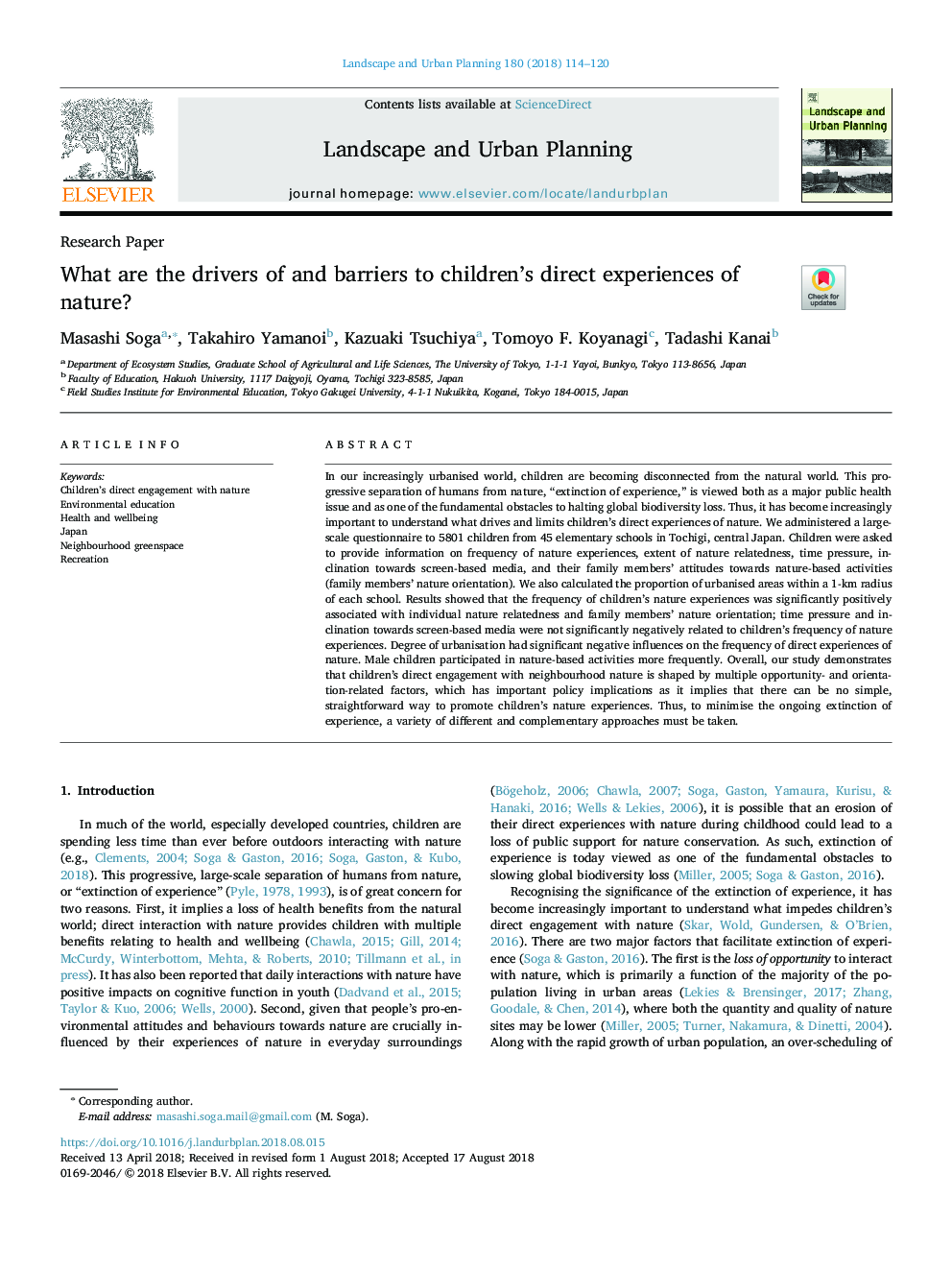| کد مقاله | کد نشریه | سال انتشار | مقاله انگلیسی | نسخه تمام متن |
|---|---|---|---|---|
| 9953206 | 1484578 | 2018 | 7 صفحه PDF | دانلود رایگان |
عنوان انگلیسی مقاله ISI
What are the drivers of and barriers to children's direct experiences of nature?
ترجمه فارسی عنوان
موانع و موانع تجربی مستقیم طبیعت کودکان چیست؟
دانلود مقاله + سفارش ترجمه
دانلود مقاله ISI انگلیسی
رایگان برای ایرانیان
کلمات کلیدی
تعامل مستقیم کودکان با طبیعت، آموزش و پرورش محیط زیست، بهداشت و سلامت، ژاپن، فضای سبز محله، تعطیلات،
ترجمه چکیده
در دنیای فزاینده شهری، کودکان از دنیای طبیعی جدا می شوند. این جدا شدن مترقی از انسان از طبیعت، انقراض تجربه، یک ؟؟ هر دو به عنوان یک مسئله مهم بهداشت عمومی و به عنوان یکی از موانع اساسی برای متوقف کردن جهانی از دست رفتن تنوع زیستی است. بنابراین، به طور فزاینده ای مهم است که فهمیدیم که تجربیات مستقیم طبیعت طبیعت چیست و محدود می شود. ما یک پرسشنامه در مقیاس بزرگ را برای 5801 کودک از 45 مدرسه ابتدایی در توچیگی، مرکزی ژاپن اداره کردیم. از کودکان خواسته شد اطلاعات مربوط به فراوانی تجارب طبیعت، میزان وابستگی طبیعت، فشار زمان، تمایل به رسانه های مبتنی بر صفحه نمایش و نگرش اعضای خانواده آنها نسبت به فعالیت های طبیعت (جهت گیری طبیعت اعضای خانواده) ارائه شود. ما همچنین نسبت مناطق شهری را در شعاع 1 کیلومتری هر مدرسه محاسبه کردیم. نتایج نشان داد که فراوانی تجارب طبیعت کودکان به طور معنی داری با ارتباط ماهیت فرد و گرایش به طبیعت اعضای خانواده ارتباط دارد؛ فشار زمان و تمایل به استفاده از رسانه های مبتنی بر صفحه به طور معناداری با فراوانی تجارب طبیعی کودکان ارتباط نداشت. درجهبندی شهرنشینی تأثیر منفی معناداری بر فراوانی تجربیات مستقیم طبیعت داشته است. کودکان مذکر بیشتر در فعالیت های طبیعت شرکت می کنند. به طور کلی، مطالعه ما نشان می دهد که تعامل مستقیم کودکان با طبیعت محله با عوامل متعدد گوناگون فرصت و جهت گیری شکل می گیرد که دارای پیامدهای مهم سیاسی است؛ به این معنی که هیچ راهی ساده و مستقیم برای ارتقاء تجارب طبیعت کودکان وجود ندارد. بنابراین، برای به حداقل رساندن انقراض مداوم تجربه، رویکردهای مختلف و مکمل باید مورد استفاده قرار گیرد.
موضوعات مرتبط
علوم زیستی و بیوفناوری
علوم کشاورزی و بیولوژیک
بوم شناسی، تکامل، رفتار و سامانه شناسی
چکیده انگلیسی
In our increasingly urbanised world, children are becoming disconnected from the natural world. This progressive separation of humans from nature, “extinction of experience,” is viewed both as a major public health issue and as one of the fundamental obstacles to halting global biodiversity loss. Thus, it has become increasingly important to understand what drives and limits children's direct experiences of nature. We administered a large-scale questionnaire to 5801 children from 45 elementary schools in Tochigi, central Japan. Children were asked to provide information on frequency of nature experiences, extent of nature relatedness, time pressure, inclination towards screen-based media, and their family members' attitudes towards nature-based activities (family members' nature orientation). We also calculated the proportion of urbanised areas within a 1-km radius of each school. Results showed that the frequency of children's nature experiences was significantly positively associated with individual nature relatedness and family members' nature orientation; time pressure and inclination towards screen-based media were not significantly negatively related to children's frequency of nature experiences. Degree of urbanisation had significant negative influences on the frequency of direct experiences of nature. Male children participated in nature-based activities more frequently. Overall, our study demonstrates that children's direct engagement with neighbourhood nature is shaped by multiple opportunity- and orientation-related factors, which has important policy implications as it implies that there can be no simple, straightforward way to promote children's nature experiences. Thus, to minimise the ongoing extinction of experience, a variety of different and complementary approaches must be taken.
ناشر
Database: Elsevier - ScienceDirect (ساینس دایرکت)
Journal: Landscape and Urban Planning - Volume 180, December 2018, Pages 114-120
Journal: Landscape and Urban Planning - Volume 180, December 2018, Pages 114-120
نویسندگان
Masashi Soga, Takahiro Yamanoi, Kazuaki Tsuchiya, Tomoyo F. Koyanagi, Tadashi Kanai,
